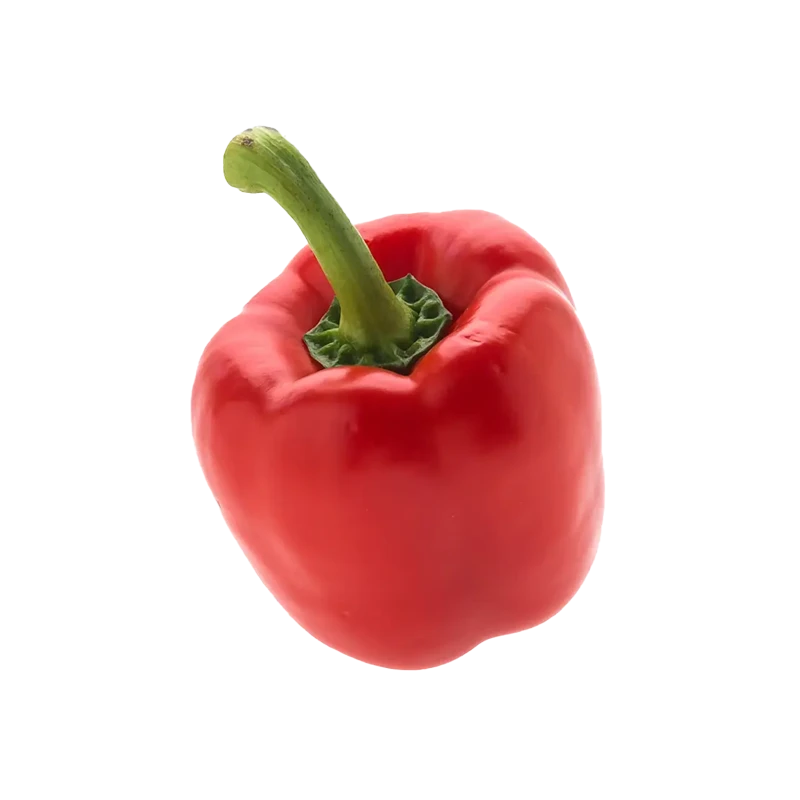Bell Pepper — Nutrients, Health Benefits, And Shopping Tips

Written by Listonic Team
Last update on September 4, 2024
Nutrients
Nutrition facts
Amount per 100 g
Calories
🔥 20 kcal
| Nutrition per: 100 g | Value | % Daily Value* |
|---|---|---|
| Carbs | 5 g | 1.82% |
| Fiber | 2 g | 7.14% |
| Sugars | 2 g | 4% |
| Glycemic Index | 40 | - |
| Protein | 1 g | 2% |
| Sodium | 3 mg | 0.13% |
| Total Fat | 0 g | - |
*The % of Daily Value (DV) tells you how much a nutrient in a serving of food contributes to a daily diet. 2,000 calories a day is used for general nutrition advice.
20
🍏 Low-Calorie Foods
40
🟢 Low Glycemic Index
Key takeaways
Health benefits
- Rich in vitamins and antioxidants, particularly Vitamin C, which supports immune function and skin health.
- Supports eye health with high levels of Vitamin A and carotenoids such as lutein and zeaxanthin.
- Low in calories while providing fiber, making them a great option for weight management and digestive health.
- Contains essential vitamins and minerals such as Vitamin B6, folate, and potassium, which are important for overall health and well-being.
Health risks
- Potential allergic reactions in some individuals, causing symptoms like itching, swelling, and difficulty breathing.
- Digestive issues such as bloating or gas, especially when consumed in large amounts or by those sensitive to nightshade vegetables.
- Pesticide residue on conventionally grown bell peppers, which can pose health risks over time if not properly washed.
- Possible interaction with certain medications particularly in individuals on a low-potassium diet, as bell peppers contain potassium.
How to choose bell pepper
Bell peppers should be bright and glossy with firm skin, feeling heavy for their size, which indicates they are fresh and moist. The stem should be green and intact.
Discard bell peppers showing any soft spots, wrinkles, or holes, as these imperfections can suggest decay or insect damage. Wilted or limp peppers won't crisp well when cooked.

How to store bell pepper
Bell peppers should be stored in the refrigerator, preferably in the crisper drawer. Keeping them in a perforated plastic bag helps maintain their crispness and freshness. Bell peppers can last up to a week when stored properly.
Excess moisture can cause bell peppers to become slimy and spoil, so it's best to avoid this. Do not wash bell peppers before storing, as moisture can accelerate spoilage. Keeping them away from ethylene-producing fruits helps extend their freshness.
✅ Extra Tip
How long does it last?
Bell peppers can last for 1-2 weeks in the refrigerator. To maintain their freshness, store them in the crisper drawer. For longer storage, bell peppers can be chopped and frozen, lasting up to 6-12 months.
What to do with leftovers?
Leftover bell peppers can be used in a wide range of dishes. Slice them and add to salads or sandwiches for a fresh crunch, or sauté them with onions and garlic for a quick stir-fry or fajita filling.
Bell peppers are excellent in pasta dishes, where they add sweetness and color. You can also stuff them with grains, vegetables, and cheese for a hearty stuffed pepper dish. If you have a lot of bell peppers, consider roasting them and using them in a roasted pepper dip or spread. Bell peppers can also be chopped and added to omelets, quiches, or frittatas for a flavorful breakfast. For a simple side dish, grill the peppers and serve with a drizzle of olive oil and balsamic vinegar, or use them as a topping for pizzas and flatbreads.
👨⚕️️ Medical disclaimer
Discover products from other categories
Listonic Team
Fact-checked
Our editorial team checked this article to make sure it was accurate at the time of publishing it.
Get the top-rated shopping list app on your phone!







